2023 Pipeline Report: Testing the Limits
Our annual report spotlighting notable investments in new drug development captures a mix of gradual gains and giant leaps—both equally as promising—in five expanding and diverse therapeutic areas: spinal muscular atrophy, hemophilia A, intranasal and inhaled vaccines, gene-targeted therapy, and RNA therapeutics.
In drug development, innovation happens in two ways: Incrementally, with each iteration of a product marked by slight improvements over what came before it, or exponentially, with new drugs boasting efficacy or safety profiles that are orders of magnitude better than existing therapies. Both approaches hold value. Perfecting established drugs, or finding new ways to apply the principles that underlie them, is equally as innovative as developing new treatments. Moreover, both approaches are imperative to meet gaps in the market and serve patients’ short-term and long-term healthcare needs.
The emerging drugs in the development pipeline have achieved a mix of both, building on therapies that have already been established while also uncovering innovative new approaches that offer unique benefits. Pharm Exec’s 18th Annual Pipeline Report profiles the best and most noteworthy of these medications, as supported by data from Clarivate Analytics.*
New SMA drugs give patients hope
Spinal muscular atrophy (SMA) is a complex condition with a poor prognosis. While some forms of SMA still permit patients to have a typical lifespan with the proper medical care, other forms are often fatal within two years.1 Currently there exists no cure; however, emerging new drugs are showing promise in helping to manage this disease.
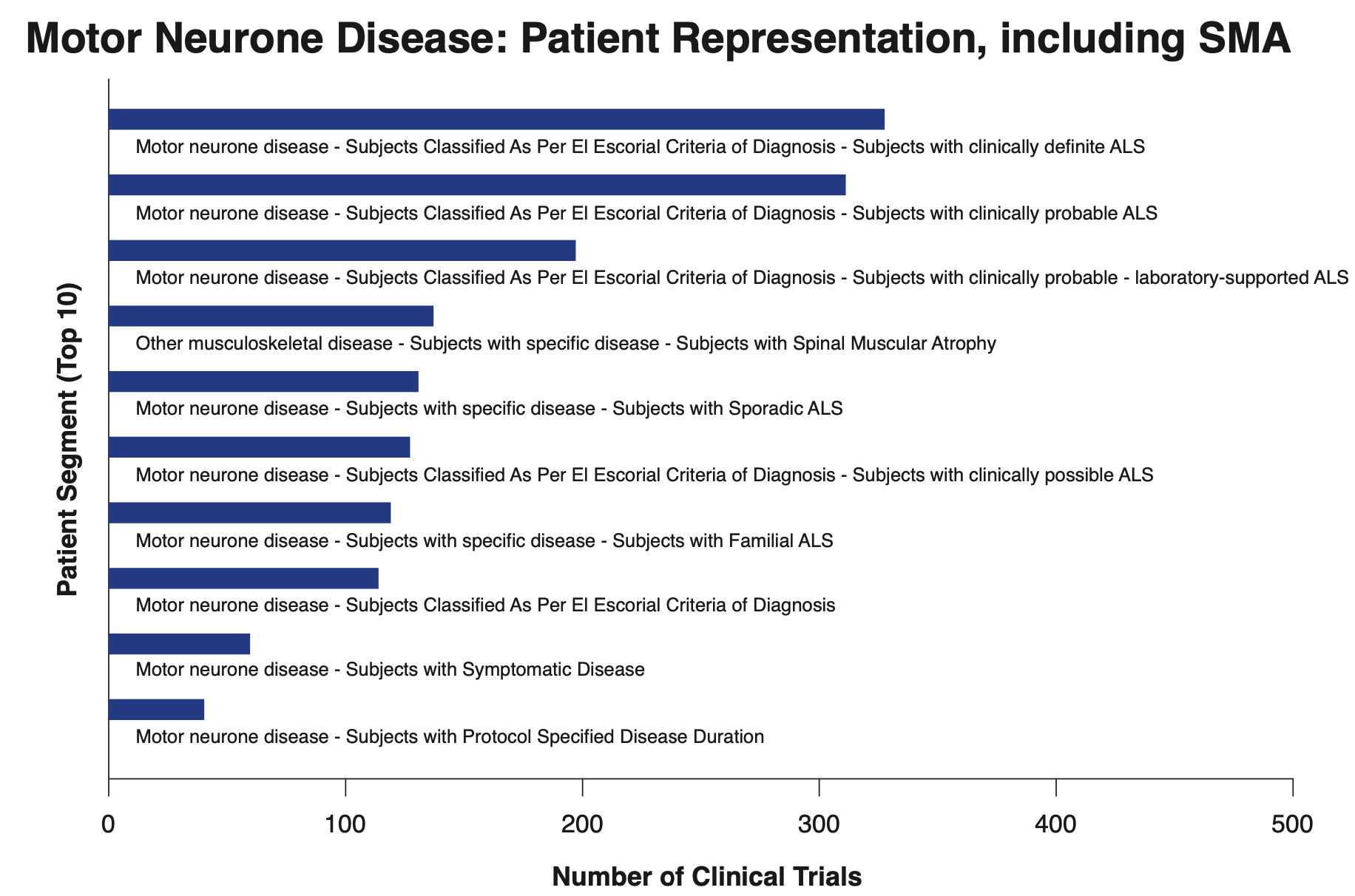
William Orent, PhD, life science expert at DeciBio in Los Angeles, says there’s currently a discussion underway around how to change the disease course of SMA in a meaningful way. While gene therapies already exist, Orent says potential newer solutions aim not to manage the disease, but to cure it.
“SMA is the perfect example of diseases being targeted by gene therapy right now,” notes Orent. “It has a clear etiology, and if we can make a genetic edit early enough, we can make an impact. There’s an approved treatment called Zolgensma, and it’s making a dramatic change for patients who receive it early. We should expect to see more going on in gene therapies.”
Zolgensma (onasemnogene abeparvovec-xioi) is a gene therapy sold by Novartis that is administered as a single, one-time intravenous infusion of vector genomes. It’s delivered through an adeno-associated virus vector after a 30-day course of systemic corticosteroids. FDA approved Zolgensma in 2019 for treatment of SMA in patients under age 2 with SMN1 mutations.
In May 2021, Novartis published the results of a five-year extension of its Phase I START trial on Zolgensma. This long-term follow-up safety study monitored 13 patients with SMA type 1 who had been treated with Zolgensma during START; SMA type 1 is typically fatal and usually kills infants before age 2.2 In the trial, however, 10 patients who had received a therapeutic dose were still alive five years after treatment. They were also breathing independently and had maintained their previous motor activity improvements five years after treatment.3
While Zolgensma is showing strong results in trials and has FDA approval, it remains prohibitively expensive. In December 2021, the Journal of Market Access & Health Policy awarded Zolgensma the unenviable distinction of being “the world’s most expensive drug.”4 A single dose of the infusion costs $2.1 million; the drug’s price tag is a result of the expensive manufacturing process involved in creating gene therapy products.5
Orent says that gene therapies are very expensive, which is why ROI becomes a challenge, especially in countries with single-payer healthcare systems. However, Orent believes, Zolgensma is such a clear value-add that most countries do end up covering something like it. Still, the pursuit for other SMA drugs will continue unless Zolgensma comes down in price.
Another SMA drug in development, intrathecal OAV101, is also a gene therapy; it is a Novartis drug as well and is showing promise in clinical studies. The STEER trial on intrathecal OAV101 had been previously put on hold; in August 2021, FDA lifted the hold after seeing favorable data from a toxicology study.6 Novartis is currently running STEER, a Phase III randomized, double-blind, placebo-controlled trial. The study is notable in that its subjects are older than most SMA patients; the trial aims to improve motor function in type 2 SMA patients between ages 2 and 18. The STEER trial will involve over 100 subjects and will assess motor function using the Hammersmith functional motor scale (HFMS), Expanded. STEER builds on the previous STRONG trial, a Phase I/II study that showed significant increases in HFMS scores in patients.7
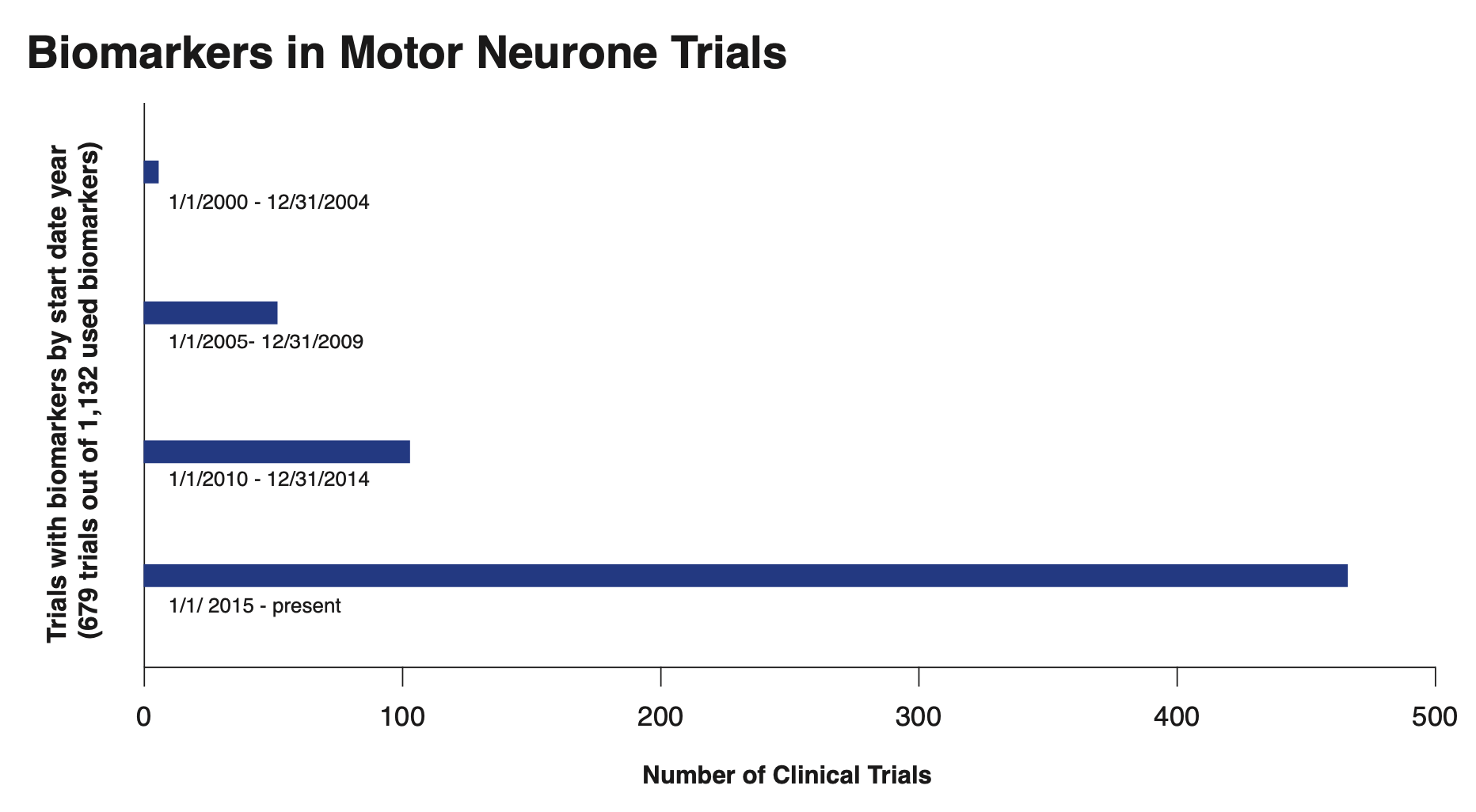
An additional Phase IIIb clinical trial, known as STRENGTH, will assess the safety, tolerability, and efficacy of intrathecal OAV101 in subjects aged 2 to 12 years with SMA who had previously been treated with nusinersen or risdiplam. This trial is slated to end in October 2024.8
Two other drugs in development for SMA include nusinersen and taldefgrobep alfa.
While nusinersen was FDA-approved in 2016 and was the first SMA drug to hit the market, ongoing research has revealed new insights that could improve its efficacy. Secondary analysis of data from the CS3A and ENDEAR studies found that higher concentrations of nusinersen in cerebrospinal fluid were associated with a greater decrease in pNF-H concentrations as well as higher drug efficacy.9 Nusinersen is currently undergoing a Phase II/III trial, the DEVOTE study, to further examine the dose-response relationship and to assess the safety, efficacy, and pharmacokinetics of higher doses.10 This study of 145 subjects will assess the effects of nusinersen in loading doses of up to 50mg and maintenance doses of up to 28mg/day.
Meanwhile, Biohaven is currently running a Phase III clinical trial on the biologic taldefgrobep alfa, a modified adnectin that acts as a myostatin inhibitor. Known as the RESILIENT trial, it is examining the effects of taldefgrobep alfa in 180 patients who are already on risdiplam or nusinersen, or who have been previously treated with Zolgensma.11 The trial started in July 2022 and is slated to end in January 2025. It will examine the effects of a 35mg or 50mg weekly subcutaneous injection of taldefgrobep alfa, compared to a matching placebo, in subjects with SMA between the ages of 4 and 21. Participants will be assessed for motor functioning via the 32-item motor function measure over the course of 48 weeks.12
These trials are just some of the many currently underway for the treatment of SMA. Clarivate Analytics data shows that 138 clinical trials are currently underway for SMA treatments, while another 1,408 are examining drugs for other motor neuron diseases like amyotrophic lateral sclerosis (ALS). Over 200 of these trials are in Phase II, and 474 started within the last seven years.
Intranasal and inhaled vaccines gain renewed interest
The COVID-19 pandemic has resulted in a significant resurgence in new vaccine development, with Clarivate Analytics data showing 2,625 trials for COVID vaccines alone. Over 2,000 trials for SARS-CoV-2, SARS, Middle East respiratory syndrome (MERS), and flu vaccines are recruiting, planned, or otherwise in progress. These trials are almost evenly divided between Phase I though IV. While the general vaccine market has relied on existing therapies for several years, new technological breakthroughs like mRNA development platforms and lipid nanoparticle delivery systems have fuelled a flurry of innovation in vaccines for COVID, croup, influenza, respiratory syncytial virus (RSV), and other infectious diseases. Several of the recent innovations in vaccine development have leveraged aspects of the immune system that came into sharp focus during the coronavirus pandemic.
Orent says there is growing interest in applying learnings from mucosal immunology to next-generation vaccines.
“The idea on everyone’s mind is how to boost immune activity at the site of infection,” he explains. “That’s why the market is looking at mucosal immunity.”
Joe Daccache, PhD, senior life science expert at DeciBio, says the primary activity in intranasal vaccines is around COVID. While RSV vaccines are starting to pick up, researchers are increasingly looking for next-generation COVID vaccines that can perform better than the current vaccines at reducing transmission.
“There are intranasal mRNA vaccines in development, but they’re having trouble with the mRNA degradation,” notes Daccache. “Intranasal flu vaccines are getting some efficacy, but not to the same level as intramuscular. But intranasal vaccine development has picked up a bit.”
Other COVID studies are taking a non-vaccine approach to prophylaxis. One Phase II/III trial currently underway, PROTECT-V, is designed to examine the efficacy of multiple prophylactic agents in preventing COVID infection among high-risk patient populations. The study authors note that a need for COVID prophylactics exists among immunocompromised patients who do not mount an adequate immune response after vaccination. The PROTECT-V trial, sponsored by the Cambridge University Hospital NHS Foundation Trust, will examine the efficacy of niclosamide, ciclesonide, and sotrovimab as COVID prophylactics in 1,500 patients with renal disease. The George Institute is sponsoring a parallel study involving 750 patients in India. The study, which will eventually enroll 5,000 patients, began in February 2022 and is estimated to end in October 2024.13
Meanwhile, development of intranasal COVID vaccines has expanded beyond mRNA. One October Phase 1 trial funded by AstraZeneca assessed the tolerability and immunogenicity of an intranasal version of the ChAdOx1 adenovirus vector COVID vaccine produced by AstraZeneca and Oxford University. In this study, 30 unvaccinated subjects received an inhaled dose of varying concentrations of viral particles. An additional 12 unvaccinated subjects received mRNA COVID vaccinations. Six subjects who had received the original ChAdOx1 intramuscular COVID vaccine and six subjects who had received two intramuscular doses of Pfizer’s Comirnaty also received a dose of viral particles. Subjects were monitored for adverse events and for mucosal antibody response.
This trial found that both vaccines were well tolerated. While the participants’ systemic immune responses were weaker relative to intramuscular immunization, the intranasal vaccine did induce mucosal antibody production in a minority of the subjects. The study authors hypothesize that the poor efficacy could be due to the vaccine using a suboptimal viral vector; a more infectious virus that better targets the respiratory system may serve as a better vector for an intranasal vaccine. The authors note that adding mucosal adjuvants may also elicit a stronger immune response.14 While the trial did not produce favorable results, the fact that the vaccine induced an immune response—albeit a weak one and only in some participants—serves as proof of concept that an intranasal COVID vaccine is possible. Still, there is much work to be done to make such a vaccine mass-market viable.
Another notable vaccine candidate aims to prevent croup in children. Currently, no vaccine for the condition exists15; this new candidate would be the first croup prophylactic to hit the market. An open-label, single-group Phase 1 clinical trial sponsored by St. Jude Children’s Research Hospital in Seattle will assess the safety of a live intranasal vaccine in 54 children aged 12 months to 6 years. The trial will use a live intranasal vaccine based on the Enders strain of the Sendai virus to induce immunity; researchers will monitor the children for six months and assess for rates of serious illness and production of antibodies.
While this is a relatively novel approach in humans, this viral vector vaccine has produced favorable results in animal studies; the animals in question developed protection against croup without developing illness. The study authors note that previous pilot trials in humans have found the vaccine to have no serious side effects.16
Gene-targeted therapy expands within and outside oncology
Oncology has been driving cell and gene therapy (CGT) development, with some of the early breakthroughs in precision medicine indicated for breast and cervical cancer. Now, however, major advances in precision medicine have given drug companies a reason to look at CGTs for other indications. Orent notes that emerging work in the RNA space has enabled more specific gene targeting, with new approaches involving sRNA and oligotherapies expanding therapeutic options.
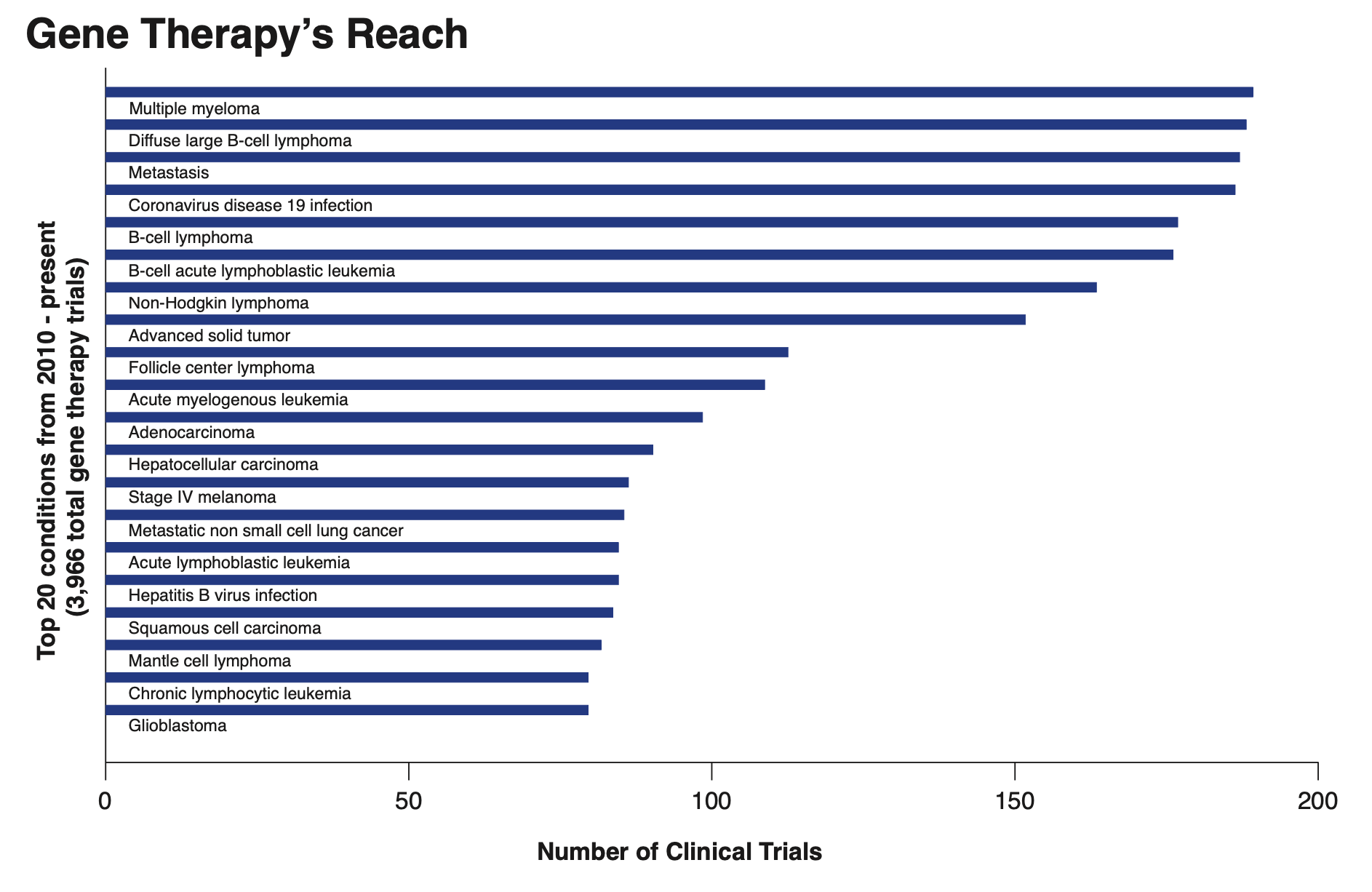
“We’ve taken major steps in our understanding of what it means to do gene targeting,” says Orent. “We’ve moved on from early attempts like Herceptin, and have created therapies that can go after these variants across modalities. The top indications for precision therapies aren’t in oncology—they’re things like muscular dystrophy and hemophilia.”
Mike Ward, global head of life sciences and healthcare thought leadership at Clarivate, points out that gene-targeted therapies have seen a significant uptick in recent years. While in years past, 15% of newly FDA-approved drugs were precision, or personalized, medicines, that number now sits somewhere between 30% and 40%, notes Ward. Most of the drugs in late-stage clinical trials are associated with oncology or rare diseases, where gene-targeted therapies rule.
“We’re also seeing the emergence of gene-targeted therapies in other therapeutic areas,” he says. “We’re on the cusp of precision psychiatry, which 10 years ago would’ve been a pipe dream. The revolution going on in psychiatry in the coming decade could look a lot like the advances we’ve seen in oncology in the last 10 years.”
Clarivate data shows that from 2000 to 2009, there were 6,198 clinical trials involving gene therapies, mostly for cancer conditions. From 2010 to present, the top three conditions examined in gene therapy clinical trials were multiple myeloma with 185 trials, diffuse large B-cell lymphoma with 184 studies, and metastasis with 181.
However, gene therapies are also taking aim at the coronavirus and other non-cancer conditions. The No. 4 such condition gene therapy trials targeted was COVID, with 180 trials. Other studies are currently underway for conditions such as refractory angina and hemophilia.
One Phase III clinical trial currently underway is examining the efficacy of tisotumab vedotin, an antibody-drug conjugate that combines the monoclonal antibody tisotumab and the cell division inhibitor monomethyl auristatin E, for the treatment of cervical cancer. This open-label study is assessing the effects of tisotumab vedotin compared to the investigator’s choice of one of five chemotherapy drugs (topotecan, vinorelbine, gemcitabine, irinotecan, and pemetrexed) in 482 women with recurrent or metastatic cervical cancer. The study is expected to have preliminary results in 2024 and be completed in 2028.17 Tisotumab vedotin gained FDA approval in September 2021 following an open-label multicenter single-arm trial and is sold under the brand name Tivdak.18 The open-label trial, a Phase II single-arm study involving 102 subjects, found that the drug showed clinically meaningful anti-cancer activity in 24% of subjects. While the drug caused one subject to die of septic shock, the study authors say the relatively poor prognosis for metastatic cervical cancer and a dearth of new drugs for this disease area warrants continuation of the drug’s development.19
Another gene therapy currently in Phase III trials aims to use a DNA approach to treat hemophilia B. The investigational drug etranacogene dezaparvovec (AMT-061), is a viral vector drug that uses an AAV5 virus to deliver the Padua variant of factor IX. The drug, developed by uniQure, recently completed the Phase III HOPE-B trial, which showed favorable results. The 78-week non-randomized sequential-assignment trial, sponsored by CSL Behring, examined the effects of AMT-061 on annualized bleeding in 54 patients with hemophilia B. In October, the trial reported preliminary results; the investigational drug maintained stable factor IX expression for a minimum of 12 months while also reducing annualized bleeding.20,21
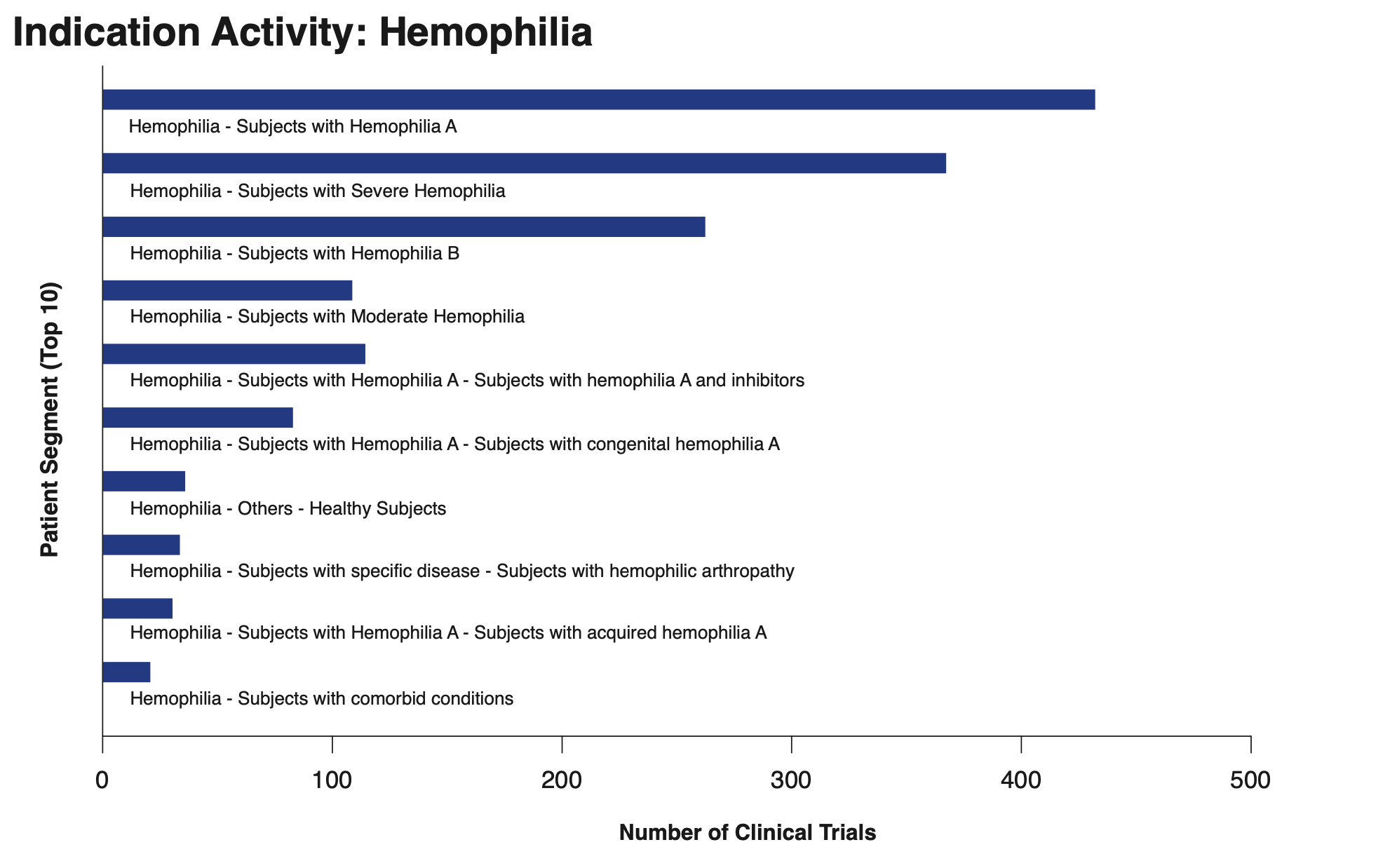
Perhaps one of the most unexpected areas where gene therapies are emerging is in cardiovascular medicine. Past research reviews have found that the gene therapy alferminogene tadenovec could improve exercise capacity; however, this candidate has struggled in clinical trials. Two Phase IIb/Phase III studies in the early 2000s were terminated prematurely due to an unexpectedly strong placebo effect.22
Now, however, researchers have returned to gene therapy as a potential treatment for angina. A Phase III trial sponsored by Angionetics will start recruiting patients in January.23 This parallel-assignment trial will assess the effects of Ad5FGF-4, an adenovirus serotype 5 virus expressing the gene for human fibroblast growth factor-4, on subjects with angina. The trial will measure frequency of angina attacks, exercise duration, frequency of nitroglycerin usage, and quality of life in 160 participants, with exercise tolerance test duration as the primary endpoint.
Hemophilia medications undergo intense discovery
There exists considerable research activity in hemophilia A drugs; Daccache says this disease area accounts for most of the activity in gene therapies. This is a significant shift for drug manufacturers, with conventional therapies falling by the wayside.
Most recently, BioMarin’s Roctavian (valoctocogene roxaparvovec) was approved by the European Commission in August. Roctavian first underwent an open-label Phase I/II safety trial starting in December 2020. The trial, which is still recruiting patients, will continue collecting safety, tolerability, and efficacy data until February 2029.24 A concurrent Phase III study involving 22 participants is currently underway, with initial data expected in January. This trial, examining the safety and efficacy of Roctavian in hemophilia A patients who are taking prophylactic corticosteroids, will run until January 2027.25

According to Ward, Roctavian is designed to reduce the number of bleeding events in hemophiliacs, which can rid patients of the need for burdensome prophylactic treatments. The drug is designed to reduce the need for replacement factor VIII. “Clarivate analysts are forecasting that Roctavian could reach annual sales of $500 million per year by 2031,” says Ward. “We’ve identified Roctavian as a drug to watch. It’s up for FDA discussion in early 2023.”
While Roctavian is showing strong signs of commercial potential, other contenders are also demonstrating favorable results. Daccache says competition in hemophilia A treatments is intense; DeciBio data shows four clinical trials involving gene therapies and one trial of a nucleic acid therapy in progress. “This is going to be most of the activity in gene therapies,” contends Daccache. “A lot of things are in the discovery stage and are quite promising.”
Clarivate data shows 911 total hemophilia drug trials underway; 641 of them are for patients with type A hemophilia. A large majority of these trials were launched after 2015, and a number of them are currently in Phase III.
While Roctavian is promising, pharma manufacturers continue to investigate other therapies. Larger companies such as Sanofi and Roche, as well as smaller biotechs like Spark Therapeutics, are investing in hemophilia research.
Sanofi’s investigational drug efanesoctocog alfa, previously designated BIVV001, is a factor VIII replacement therapy formulated as a once-a-week dose. In February 2021, efanesoctocog alfa was granted FDA fast-track designation following its declaration of orphan-drug status in 2017.26 The treatment uses von Willebrand factor and XTEN-branded polypeptides to extend its activity and increase half-life.
Efanesoctocog alfa is currently being studied in a long-term safety and efficacy trial, called XTEND-ed, in patients who had previously been treated for hemophilia A. The Phase III open-label trial involving 262 participants aims to assess the effects of efanesoctocog alfa on factor VIII neutralizing antibodies. Secondary outcome measures include number and type of bleeding episodes, physician’s global assessment of response prior to treatment, and change from baseline Hemophilia Joint Health Score. The trial is currently recruiting patients and is estimated to end in 2027.27
An investigational drug by Spark, SPK-8011, hopes to affect factor VIII expression in a different manner. It is a gene therapy that uses a bioengineered adeno-associated viral vector to deliver a human factor VIII gene using a liver-specific promoter. In November 2021, Spark announced the results of a Phase I/II clinical trial involving 18 participants. After 33 months, 16 of the 18 subjects had sustained FVIII production and experienced a reduction in bleeding episodes.28 The study found a 91.5% reduction in annualized bleeding, from an average of 8.5 bleeding events per year before treatment to 0.3 events per year after treatment.29
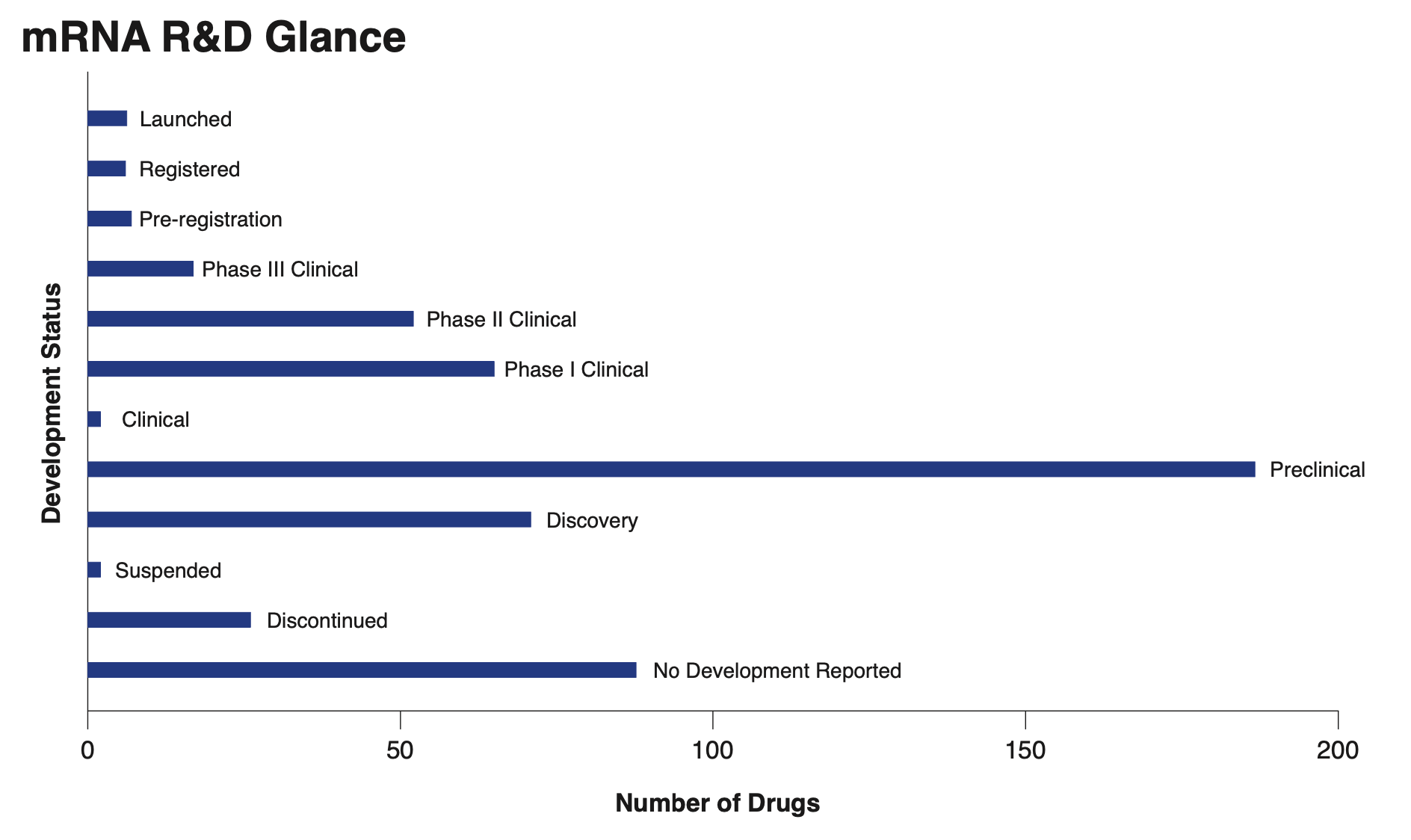
RNA therapeutics diversify disease areas
RNA therapeutics are also undergoing intense development, with both mRNA, which produces certain compounds, and antisense RNA, which inhibits the production of compounds. There are currently multiple Phase II and III trials underway, as well as hundreds of preclinical studies.
“We’re also seeing expansion across applications,” notes Orent. “It started out with a COVID vaccine strategy, but Moderna has been building their oncology team, and they’re also looking at autoimmune disorder vaccines. The indications mRNA can be used for are increasing.”
Daccache notes that M&A activity in the RNA space has remained strong, and companies are starting to move away from untargeted mRNA to more directed, cell-specific therapies. Targeted nucleic acid vaccines and therapies are showing promise not only for infectious diseases, but also neurology and other areas.
Moderna is currently running a Phase III trial on its mRNA-1647 candidate, a vaccine for cytomegalovirus (CMV). While CMV infections are generally quite mild, a pregnant woman who contracts the virus can transmit it to her fetus; in utero CMV infection can cause permanent disability or death in the child.30 This trial is recruiting subjects and intends to follow 6,900 women for 2.5 years.
Another Moderna vaccine candidate, mRNA-1345, currently in development is targeting RSV. It’s undergoing a Phase II/III trial on adults over the age of 60. The study is still recruiting participants, and aims to eventually enroll 34,000 seniors. It’s being conducted in two stages, with 400 to 2,000 subjects participating in the Phase II segment. Following that, roughly 32,000 subjects will participate in the Phase III segment. All subjects will be randomly assigned to receive either a placebo or one dose of the mRNA-1345 vaccine. Subjects will be assessed for number and severity of adverse reactions and vaccine efficacy at preventing infection and hospitalization and at inducing the production of neutralizing antibodies.31
While mRNA has received much press since the original COVID vaccines were developed, other producers are looking at options involving self-amplifying RNA or combined RNA/mRNA vaccines. Arcturus Therapeutics currently has RNA/mRNA vaccines in development for COVID and influenza, as well as RNA/mRNA therapeutics targeting ornithine transcarbamylase deficiency and cystic fibrosis.
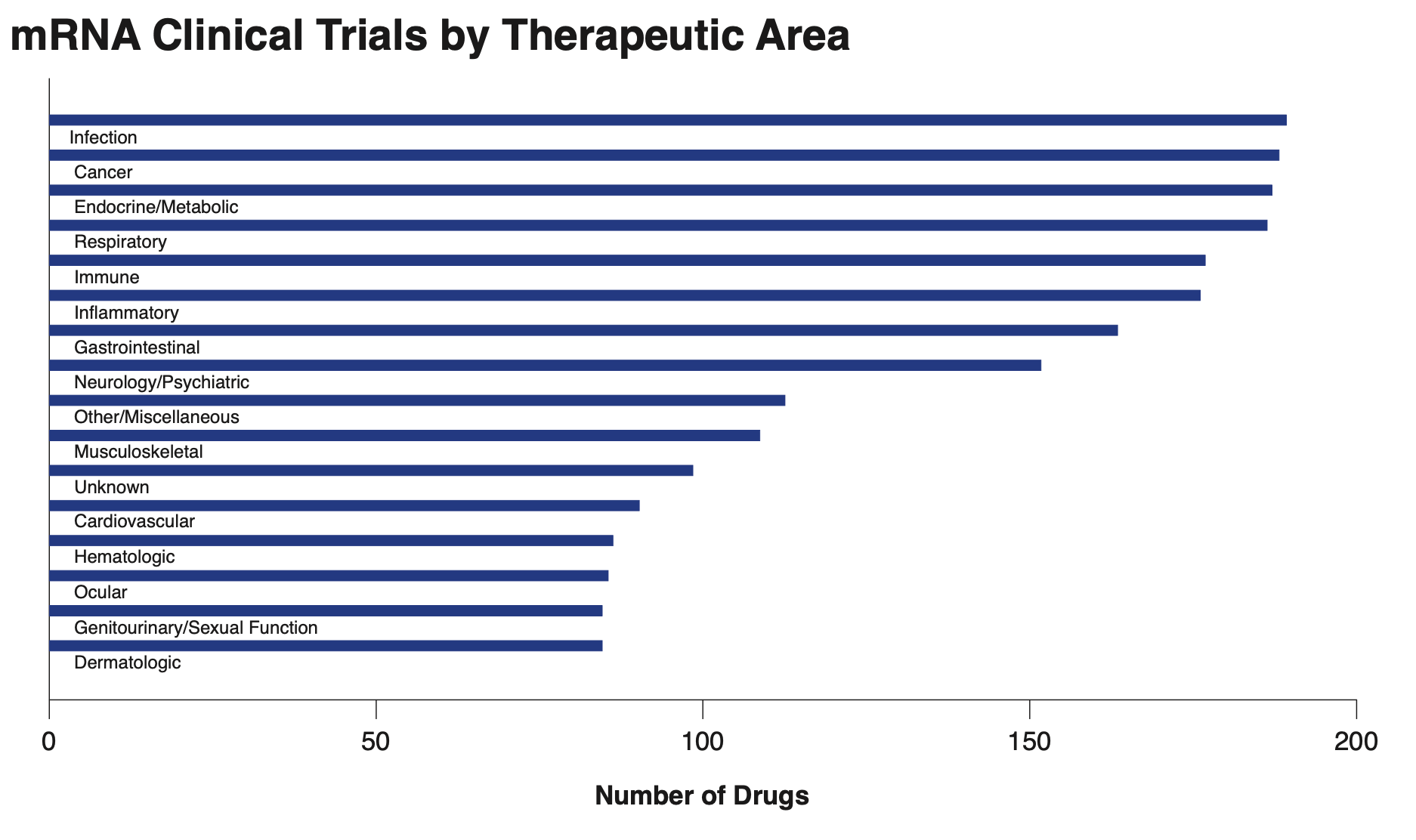
Arcturus’ ARCT-154 COVID vaccine is the most developed of these product candidates. ARCT-154, also known as LUNAR-COV19, is a self-replicating RNA/mRNA vaccine that uses an RNA delivery mechanism to insert spike protein-encoding mRNA into cells. Arcturus claims that an mRNA vaccine delivered using self-replicating RNA can enable smaller doses, as little as 5 micrograms, which would accelerate rollout and reduce manufacturing costs.32 The current trial underway on ARCT-154 is a combination Phase I/II/III study sponsored by Vinbiocare. It will be performed in four parts that will assess the safety, immunogenicity, and efficacy of the vaccine. The final phase will pit ARCT-154 against AstraZeneca’s ChAdOx1 COVID vaccine to determine whether ARCT-154 presents a non-inferior safety and efficacy profile. The trial will eventually enroll 19,400 participants and is expected to be complete in August 2023.33
While much ado has been made about mRNA vaccines, emerging drugs in development are also pursuing mRNA as a delivery mechanism for therapeutics. Clarivate’s data shows that more than 190 mRNA candidates are in preclinical development, with 135 drugs or vaccines in various stages of clinical trials. While the largest proportion of these products are designed to treat or prevent infection, there are also mRNA vaccines and therapeutics in development for cancer and metabolic, respiratory, and psychiatric conditions.
Ward says the enthusiasm for mRNA and RNA was spurred by the pandemic. COVID vaccines served as proof of concept for mRNA, he notes, which, in turn, has fueled the rise in development of next-generation RNA and mRNA technology, including self-amplifying RNA. “There’s a lot of RNA technologies that companies are trying to get access to,” says Ward. “We’ve seen a big increase in the number of deals associated with RNA platforms. We’ve even seen some RNA drugs get approved, and more are coming down the line.”
Ward believes the RNA market is particularly exciting given that Moderna and BioNTech (Pfizer’s Germany-based partner on Comirnaty) originally developed their COVID mRNA vaccines for oncology purposes. The pandemic forced both companies to pivot, and that pivot was successful. Now, the major players in RNA and mRNA have the funds to research other disease areas.
“Pfizer and Moderna are refocusing their efforts back on the development of mRNA vaccines for oncology, which is one of the things we’ll be interested to see,” says Ward. “The amount of money both companies were able to make from the COVID vaccines means they’ll be able to really accelerate the scale-up of their activities in the oncology space.”
Pushing the boundaries in R&D
The therapeutics and vaccines currently in development are testing the boundaries of their fields. SMA drugs such as Zolgensma are delivering life-changing results to trial subjects, while new intranasal and inhaled vaccines have provided proof-of-concept around mucosal immunity. Gene-targeted therapies and precision medicines are expanding into unexpected areas such as psychiatry, while new hemophilia A medications show great efficacy improvements over their predecessors. Permeating the entire field of modern drug development is the RNA and mRNA development platform that the COVID pandemic brought about.
The biopharma pipeline is full of innovative and promising vaccines and therapeutics, with a good number of Phase III candidates nearing potential market readiness. The number and scale of advances in the pipeline mean drugmakers will find ample opportunities for commercialization in these five therapeutic areas and modalities outlined.
*The data provided in the charts on the following pages does not purport to represent complete datasets. All data is based on specific remit and search criteria. Data provider Clarivate Analytics and Pharmaceutical Executive do not make any warranties or representations regarding the completeness of the data presented.
Mike Straus is a freelance writer based in British Columbia, Canada. His work has appeared in Nutritional Outlook, Hoist, and Massage Therapy Canada, among other publications.
References
- National Institutes of Health: National Institute of Neurological Disorders and Stroke. “Spinal muscular atrophy.” Updated July 25, 2022.
- Park HB et al. “Survival analysis of spinal muscular atrophy type I.” Korean Journal of Pediatrics, vol. 53 no. 11 (November 2010): 965-970.
- Mendell JR et al. “Five-year extension results of the Phase 1 START trial of onasemnogene abeparvovec in spinal muscular atrophy.” JAMA Neurology, vol. 78 no. 7 (July 2021): 834-841.
- Nuijten M. “Pricing Zolgensma – the world’s most expensive drug.” Journal of Market Access & Health Policy, vol. 10 no. 1 (January 2022): 2022353.
- Cumbers J. “Why some drugs cost $2.1 million per dose and how one company plans to change this.” Forbes. Published online Dec. 16, 2021.
- “Novartis announces lift of partial clinical trial hold and plans to initiate a new, pivotal Phase 3 study of intrathecal OAV-101 in older patients with SMA.” Novartis. Published online Aug. 3, 2021.
- “STEER trial results.” Spinal Muscular Atrophy UK. Updated Feb. 22, 2022.
- ClinicalTrials.gov. “Phase IIIb, open-label, multi-center study to evaluate safety, tolerability and efficacy of OAV101 administered intrathecally to participants with SMA who discontinued treatment with Nusinersen or Risdiplam (STRENGTH).” ClinicalTrials.gov Identifier: NCT05386680.
- Finkel RS et al. “Scientific rationale for a higher dose of nusinersen.” Annals of Clinical and Translational Neurology, vol. 9 no. 6 (June 2022): 819-829. Published online ahead of print May 13, 2022.
- ClinicalTrials.gov. “Study of Nusinersen (BIIB058) in participants with spinal muscular atrophy (DEVOTE).” ClinicalTrials.gov Identifier: NCT04089566.
- Biohaven Pharmaceuticals. “Biohaven enrolls first patient in phase 3 trial of taldefgrobep alfa in spinal muscular atrophy (SMA).” Published online July 7, 2022.
- ClinicalTrials.gov. “A study to evaluate the efficacy and safety of taldefgrobep alfa in participants with spinal muscular atrophy (RESILIENT).” ClinicalTrials.gov Identifier: NCT05337533.
- ClinicalTrials.gov. “Prophylaxis for patients at risk of COVID-19 infection –V (PROTECT-V).” ClinicalTrials.gov Identifier: NCT04870333.
- Madhavan M et al. “Tolerability and immunogenicity of an intranasally-administered adenovirus-vectored COVID-19 vaccine: An open-label partially-randomized ascending dose phase 1 trial.” The Lancet eBioMedicine (Oct. 2022): 104298. Published online ahead of print Oct.10, 2022
- Woods CR. “Patient education: Croup in infants and children (Beyond the Basics).” UpToDate. Reviewed October 2022.
- ClinicalTrials.gov. “A study to assess the safety of live intranasal Sendai virus vaccine in children and toddlers.” ClinicalTrials.gov Identifier: NCT00186927.
- ClinicalTrials.gov. “Tisotumab vedotin vs chemotherapy in recurrent or metastatic cervical cancer (innovaTV 301).” ClinicalTrials.gov Identifier: NCT04697628.
- FDA. “FDA grants accelerated approval to tisotumab vedotin-tftv for recurrent or metastatic cervical cancer.” Published online Sept. 21, 2021.
- Coleman RL et al. “Efficacy and safety of tisotumab vedotin in previously treated recurrent or metastatic cervical cancer (innovaTV 204/GOG-3023.ENGOT-cx6): a multicentre, open-label, single-arm, phase 2 study.” The Lancet Oncology, vol. 22 no. 5 (609-619): May 2021. Published online ahead of print April 9, 2021.
- ClinicalTrials.gov. “HOPE-B: Trial of AMT-061 in severe or moderately severe hemophilia B patients.” ClinicalTrials.gov Identifier: NCT03569891.
- UniQure. “Hemophilia B: A potential first- and best-in-class hemophilia B gene therapy program.”
- Flynn A et al. “Alferminogene tadenovec, an angiogenic FGF4 gene therapy for coronary artery disease.” iDrugs, vol. 11 no. 4 (April 2008): 283-293.
- ClinicalTrials.gov. “Ad5FGF-4 in patients with refractory angina due to myocardial ischemia (AFFIRM).” ClinicalTrials.gov Identifier: NCT02928094.
- ClinicalTrials.gov. “Safety, tolerability, and efficacy of valoctocogene roxaparvovec in hemophilia A with active or prior inhibitors.” ClinicalTrials.gov Identifier: NCT04684940.
- ClinicalTrials.gov. “Study to evaluate the efficacy and safety of valoctogene roxaparvovec, with prophylactic steroids in hemophilia A (GENEr8-3).” ClinicalTrials.gov Identifier: NCT04323098.
- Sanofi. “Efanesoctocog alfa granted FDA Fast Track Designation for treatment of hemophilia A.” Published online Feb. 18, 2021.
- ClinicalTrials.gov. “Long-term safety and efficacy of efanesoctocog alfa (BIVV001) in previously treated patients with hemophilia A (XTEND-ed).” ClinicalTrials.gov Identifier: NCT04644575.
- Spark Therapeutics. “Spark Therapeutics updated SPK-8011 data from Phase 1/2 study shows multi-year, durable factor VIII (FVIII) expression that significantly reduced bleeding in hemophilia patients.” Published online Nov. 17, 2021.
- George LA et al. “Multiyear Factor VIII expression after AAV gene transfer for hemophilia A.” New England Journal of Medicine, vol. 385 no. 21 (2021): 1961-1973.
- Moderna. “A clinical trial of a cytomegalovirus (CMV) vaccine in healthy women 16 to 40 years of age.”
- ClinicalTrials.gov. “A study to evaluate the safety and efficacy of mRNA-1345 vaccine targeting respiratory syncytial virus (RSV) in adults ≥ 60 years of age.” ClinicalTrials.gov Identifier: NCT05127434
- Arcturus Therapeutics. “Pipeline: mRNA Medicines.”
- ClinicalTrials.gov. “The ARCT-154 self-amplifying RNA vaccine efficacy study (ARCT-154-01).” ClinicalTrials.gov Identifier: NCT05012943.

New Insights Into T Cell Exhaustion and Inflammation in Long COVID
April 17th 2025Nigel McCracken, chief operating officer, Virax Biolabs, discusses new findings that reveal altered cytokine activity and evidence of T cell exhaustion in long COVID patients, providing deeper insight into post-infection immune disruption.
Addressing Disparities in Psoriasis Trials: Takeda's Strategies for Inclusivity in Clinical Research
April 14th 2025LaShell Robinson, Head of Global Feasibility and Trial Equity at Takeda, speaks about the company's strategies to engage patients in underrepresented populations in its phase III psoriasis trials.
Amgen’s Imdelltra Demonstrates Significant Overall Survival Improvement in Small Cell Lung Cancer
April 16th 2025In the Phase III DeLLphi-304 trial, patients with small cell lung cancer administered Imdelltra achieved a statistically significant and clinically meaningful improvement in overall survival compared to standard-of-care chemotherapy.
Key Findings of the NIAGARA and HIMALAYA Trials
November 8th 2024In this episode of the Pharmaceutical Executive podcast, Shubh Goel, head of immuno-oncology, gastrointestinal tumors, US oncology business unit, AstraZeneca, discusses the findings of the NIAGARA trial in bladder cancer and the significance of the five-year overall survival data from the HIMALAYA trial, particularly the long-term efficacy of the STRIDE regimen for unresectable liver cancer.
Pfizer Discontinues Development of Danuglipron for Chronic Weight Management
April 15th 2025Despite meeting key pharmacokinetic goals, a potential case of drug-induced liver injury led Pfizer to conclude that danuglipron’s risk-benefit profile did not support further development for chronic weight management.